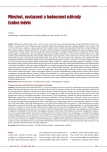Haemodialysis – the current practice
Authors:
M. Nedbálková
Authors‘ workplace:
II. interní klinika Lékařské fakulty MU a FN u sv. Anny v Brně, přednosta prof. Miroslav Souček, CSc.
Published in:
Vnitř Lék 2011; 57(7&8): 640-644
Category:
136th internal medicine day, XXIV. Vanýskův den, Brno 2011
Overview
New techniques and technological innovations developed over the last decades have facilitated improvements in haemodialysis. An emphasis is on an early insertion of arteriovenous fistula as a venous access for haemodialysis. Dialysis treatment should be initiated when the glomerular filtration rate falls to 8–10 mL/min, and to15 mL/min when the patients have risk factors. Haemodialysis is usually performed 3 times a week for 4 hours; less frequent or shorter haemodialysis is acceptable only in patients with well-preserved residual renal function. Extending haemodialysis to 5–6 hours is useful in preventing complications. Haemodiafiltration with high flux membranes, more permeable for middle molecules, is preferred in patients with long-term haemodialysis. Correct assessment of dry weight, i.e. an optimal body weight after haemodialysis without any signs of hypervolaemia, is important. Apart from a clinical assessment, body composition monitor (BCM) that uses bioimpedance to assess the proportion of water in the body, is helpful in determining dry weight. Reduction of dialysis solution temperature to 36–35 °C and blood volume monitor (BVM) that measures changes in haematocrit during water elimination, are used to prevent dialysis-associated hypotension. Potassium profiling decreases the incidence of arrhythmias in haemodialysed cardiac patients. Blood temperature monitor (BTM) is used to measure recirculation and thus to detect an arteriovenous fistula dysfunction. Protection of residual renal function through an elimination of nephrotoxic substances as well as prevention of hypotension and excessive ultrafiltrations is an important part of care for a haemodialysed patient.
Key words:
haemodialysis – initiation of haemodialysis – haemodialysis main principle – venous access – anticoagulation treatment – haemodiafiltration – duration of haemodialysis – adequate haemodialysis – dry weight assessment
Sources
1. Korevaar JC, Jansen MA, Dekker FW et al. Netherlands Cooperative Study on the Adequacy of Dialysis Study Group. When to initiate dialysis: effect of proposed US guidelines on survival. Lancet 2001; 358: 1046–1050.
2. Traynor JP, Simpson K, Geddes CC et al. Early initiation of dialysis fails to prolong survival in patients with end-stage renal failure. J Am Soc Nephrol 2002; 13: 2125–2132.
3. Stel VS, Dekker FW, Ansell D et al. Residual renal function at the start of dialysis and clinical outcomes. Nephrol Dial Transplant 2009; 24: 3175–3182.
4. US Renal Data System: USRDS 2004 Annual Data Report. Bethesda, MD: The National Institutes of Health, National Institute of Diabetes and Digestive and Kidney Diseases 2004.
5. Roubicek C, Brunet P, Huiart L et al. Timing of nephrology referral: influence on mortality and morbidity. Am J Kidney Dis 2000; 36: 35–41.
6. Stel VS, Tomson C, Ansell D et al. Level of renal function in patients starting dialysis: an ERA-EDTA Registry study. Nephrol Dial Transplant 2010; 25: 3315–3325.
7. Rosansky SJ, Clark WF, Eggers P et al. Initiation of dialysis at higher GFRs: is the apparent rising tide of early dialysis harmful or helpful? Kidney Int 2009; 76: 257–261.
8. Cooper BA, Branley P, Bulfone L et al. IDEAL Study. A randomized, controlled trial of early versus late initiation of dialysis. N Engl J Med 2010; 363: 609–619.
9. Ocak G, Halbesma N, le Cessie S et al. Haemodialysis catheters increase mortality as compared to arteriovenous accesses especially in elderly patients. Nephrol Dial Transplant 2011, Jan 31 PMID 21282302 [Epub ahead of print].
10. Rayner HC, Pisoni RL, Bommer J et al. Mortality and hospitalization in haemodialysis patients in five European countries: results from the Dialysis Outcomes and Practice Patterns Study (DOPPS). Nephrol Dial Transplant 2004; 19: 108–120.
11. Canaud B, Bragg-Gresham JL, Marshall MR et al. Mortality risk for patients receiving haemodiafiltration versus hemodialysis: European results from the DOPPS. Kidney Int 2006; 69: 2087–2093.
12. Marshall MR, Byrne BG, Kerr PG et al. Associations of hemodialysis dose and session length with mortality risk in Australian and New Zealand patients. Kidney Int 2006; 69: 1229–1236.
13. Saran R, Bragg-Gresham JL, Levin NW et al. Longer treatment time and slower ultrafiltration in hemodialysis: associations with reduced mortality in the DOPPS. Kidney Int 2006; 69: 1222–1228.
14. Charra B, Calemard M, Laurent G et al. Importance of treatment time and blood pressure control in achieving long-term survival on dialysis. Am J Nephrol 1996; 16: 35–44.
15. Powell JR, Oluwaseun O, Woo YM et al. Ten years experience of in-center thrice weekly long overnight hemodialysis. Clin Am J Soc Nephrol 2009; 4: 1097–1101.
16. Chan CT, Floras JS, Miller JA et al. Regression of left ventricular hypertrophy after conversion to nocturnal hemodialysis. Kidney Int 2002; 61: 2235–2239.
17. Culleton BF, Walsh M, Klarenbach SW et al. Effect of frequent nocturnal hemodialysis vs conventional hemodialysis on left ventricular mass and quality of life: a randomized controlled trial. JAMA 2007; 298: 1291–1299.
18. Rocco MV, Cheung AK, Greene T et al. Hemodialysis (HEMO) Study Group. The HEMO Study: applicability and generalizability. Nephrol Dial Transplant 2005; 20: 278–284.
19. Kalantar-Zadeh K, Regidor DL, Kovesdy CP et al. Fluid retention is associated with cardiovascular mortality in patients undergoing long-term hemodialysis. Circulation 2009; 119: 671–679.
20. Ronco C, Brendolan A, Milan M et al. Impact of biofeedback-induced cardiovascular stability on hemodialysis tolerance and efficiency. Kidney Int 2000; 58: 800–808.
21. Shoji T, Tsubakihara Y, Fujii M et al. Hemodialysis-associated hypotension as an independent risk factor for two-year mortality in hemodialysis patients. Kidney Int 2004; 66: 1212–1220.
22. Song JH, Lee SW, Suh CK et al. Time-averaged concentration of dialysate sodium relates with sodium load and interdialytic weight gain during sodium-profiling hemodialysis. Am J Kidney Dis 2002; 40: 291–301.
Labels
Diabetology Endocrinology Internal medicineArticle was published in
Internal Medicine

2011 Issue 7&8
Most read in this issue
- Haemodialysis – the current practice
- Anemia and chronic kidney failure
- Immunosuppressive therapy and its problems
- Aetiology and a clinical picture of chronic renal failure
